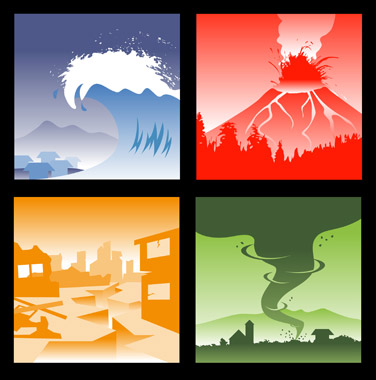Department of Defense: The Push for Natural Security
In the first semester of 2011, natural disasters had a devastating impact on human society. “Preliminary EM-DAT figures showed the occurrence of 108 natural disasters, which killed more than 23,000 people, affected nearly 44 million others and caused more than US $253 billion of economic damages. Sixty-one countries experienced a natural disaster,” according to the Centre for Research on the Epidemiology of Disasters (CRED) in Brussels, Belgium. The natural disaster that killed the most people (20,319) and that had the greatest estimated economic damage (US $210 billion) was in Japan. However, the natural disaster that affected the most people (22,000,150) was in China. In addition, the tornadoes that impacted the United States in April and May 2011 caused more than 550 deaths, affected nearly 18,000 people and created more than US$14.5 billion in economic damage.
“Despite continuing efforts to make societies more resilient to disasters, a road still lies ahead for both developed and developing countries, as shown by disaster statistics. Disaster data not only inform us on the impact of disasters, but also provide an evidence-base for gauging the effectiveness of disaster risk reduction measures,” says CRED Director Debarati Guha-Sapir.
Clearly, natural disasters, caused by either natural factors or human-induced activities, such as climate change, have a strong impact on societies and, therefore, a strong impact on both national and international security. As such, “natural security” is becoming a top priority for organizations like the North Atlantic Treaty Organization (NATO) and the U.S. Department of Defense.
From a defense perspective, this ideology has been primarily focused on energy security. But, thanks to thought leaders such as Sharon E. Burke, Assistant Secretary of Defense for Operational Energy Plans and Programs, and Katherine Hammack, Assistant Secretary of the Army (Installations, Energy & Environment), Office of the Assistant Secretary of the Army, this “emerging threat” is now being viewed more holistically.
While Vice President at the Center for a New American Security (CNAS) in 2009, Burke authored a Natural Security Working Paper, which helped to change the DoD’s outlook on natural capital and national security. According to Burke, “Natural security is a critically important yet underappreciated and underdeveloped facet of U.S. national security. . . . The challenge for the U.S. government will be not only to address natural security challenges, but how to do so in a mutually reinforcing way that builds security.” This requires a changing global strategic environment as every nation depends on energy, drinking water and arable land for its populations – access that experts agree is not assured.
“At the same time, increasing consumption of these resources has consequences, such as climate change and biodiversity loss, which will challenge the security of the United States and nations all over the world. Natural security ultimately means sufficient, reliable, affordable and sustainable supplies of natural resources for the modern global economy. This will require the United States to both shape and respond to emerging natural resources challenges in a changing strategic environment,” contends Burke.
Climate Change & Its Implications
In 2007, the Intergovernmental Panel on Climate Change (IPCC) findings noted that it is, according to Burke, “‘unequivocal’ that the climate is and will continue to change and that human generation of greenhouse gases is responsible for most related changes since the 1950s. It is possible that climate change effects will be even more dramatic than currently anticipated.

© iStockphoto.com/TonySoh
“Certainly, a failure to cut greenhouse gas emissions now will mean worse effects later in the century. Recent observations support the contention that climate change estimates have been too low. To the extent that scientists have underestimated climate change, security risks associated with climate change could be worse than anticipated, which will challenge global preparedness. Climate change will affect national security in the broadest sense.”
Hammack provides examples of these broad climate-induced national security changes as a result of drought and flooding within the United States. With respect to drought, increased temperatures and reduced rainfall have made forests dry and, therefore, more susceptible to lightning and other fires. She said that Arizona’s massive 2011 forest fires were heading toward major lines supplying power from the Palo Verde plant to New Mexico and one of the Army bases. If the installation’s power lines had been impacted, it would have caused significant disruption to the base’s primary mission.
Other climate-related natural disasters include the recent Missouri and Mississippi River floods. The Assistant Secretary explains that the flooding “certainly made us all much more conscious of the effect that waters and floods can have on our installations. And, although none of our installations were under water, the water came pretty close to them and certainly affected some of our families and our soldiers who are living off base.”
Tornadoes were also a major concern for the Army. Hammack comments that “the tornados that cut through parts of the Midwest also were challenges to national security. They brought down power lines, which meant that several of our installations were off-grid and operating on back-up generators.” Because back-up generators run on diesel, in most cases, that created another potential vulnerability – making sure enough diesel was on-hand to continue the installation’s primary mission.
“So climate does have a huge impact on our mission readiness and is something that we are all aware of and need to ensure that we have appropriate mitigation in place for,” says Hammack.
The Vulnerabilities of Energy
Burke maintains that “global dependence on oil, coal and natural gas, and the concentration of supplies in a limited number of countries means that energy resources are associated with geostrategic pressure, instability and vulnerability, including for the U.S. military.” This is aptly measured and put to the test via America’s increasingly fragile electric grid.

© iStockphoto.com/askinkamberoglu
According to Massoud Amin, PhD, energy professional and electrical engineer from the University of Minnesota’s College of Science and Engineering, large power blackouts are growing in number and severity. In his paper, The Rising Tide of Power Outages and the Need for a Stronger and Smarter Grid, his 1991-2005 collection of data revealed that “in the period from 1991 to 2000, there were 76 outages of 100MW or more in the second half of the decade compared to 66 such occurrences in the first half. Furthermore, there were 41 percent more outages affecting 50,000 or more consumers in the second half of the 1990s than in the first half (58 outages in 1996-2000 versus 41 outages in 1991-1995). Further analysis show that there were 200 outages of 100 MW or more during 2001-2005; such outages have increased to 219 during 2006-May 2010. Additionally, the number of U.S. power outages affecting 50,000 or more consumers increased from 197 (during 2001-2005) to 312 (during 2006-May 2010).”
Consistent with power interruption concerns, a 2005 study conducted by Lawrence Berkeley National Laboratory researchers estimated that electric power outages and blackouts cost the U.S. about $80 billion annually. Hammack comments that on many levels the U.S. electric grid is one of the military’s major vulnerabilities.
Regarding the grid’s vulnerability to Nature and other factors, she explains: “We’ve seen floods, tornados, earthquakes, etc., that can decimate power lines, and sometimes they take hours to replace, and sometimes they take weeks to replace. Accidents are another concern, which can be simple – from a car running into a power pole – to something more complex, such as an accident with a transformer, which affects a substation and can take several weeks to replace. Man is the third concern, whether those acts are national security threats from terrorist organizations or local acts of sabotage.
“The U.S. has a very vulnerable electricity grid, and its natural gas pipelines are just as vulnerable. America has miles and miles of unprotected power lines and unprotected natural gas pipelines, which means, from an energy standpoint, that we are not secure. The role and mission of the Army, the National Guard and Reserves is to be able to provide for the safety of the U.S. We need to be sure we are protected against these and other vulnerabilities.”
In order to combat these issues, the military has been focusing on Net Zero, which, according to Hammack, “is how we can ensure that our bases are operational regardless of what goes on around us.” The bottom line is that Net Zero programs reduce vulnerability and risk to challenges outside the military’s fence line. This priority imperative ensures the military can continue to operate and to fulfill its primary mission.
Net Zero is a revolutionary strategy because it attacks natural security threats and disasters from three sides: energy, water and waste. Although the practice ensures military installations generate as much electricity as they use, the first priority is to reduce energy usage as much as possible. This never-before-seen military focus on energy reduction and efficiency is being accomplished through a myriad of avenues from lighting to building design and maintenance to biofuels.
According to Hammack, the second priority is “to repurpose energy. In operations, an installation may have waste heat that goes out of a smokestack from a boiler. We’re seeing more and more power plants looking for ways to repurpose waste heat for beneficial use. The last priority is to produce energy from renewable resources so we aren’t vulnerable to natural gas pipelines or electricity power lines. And, renewable can be anything from hydro to solar to wind to geothermal or even biomass.” The bottom line is DoD wants to ensure that it doesn’t have a supply line that can be interrupted by natural or man-made forces.
Water as a Point of Conflict

© iStockphoto.com/AlonzoDesign
“While there may be little evidence that nations will actually declare war over water, there is certainly an ample record of conflict within societies, tension between states and other water-related national security challenges, including the use of water resources as a tool of political influence,” comments Burke.
The Assistant Secretary of Defense maintains that consumption and consequences are the two categories of consideration for natural security. Natural resource consumption “can affect geopolitics and the stability of nations. At the same time, the consequences of high consumption rates of these resources, such as climate change and biodiversity loss, can also create geostrategic pressure, instability and disaster.”
Water is a geopolitical element of instability, both nationally and internationally. This is why it is a critical component of Net Zero. In the military’s Net Zero water strategy, each installation, according to Hammack, “will ensure that it is not using more water than it can inject back into the local aquifer. We need to treat water as a precious resource, which is why the same kind of hierarchy exists for it as for energy. First, we need to reduce the amount of water we use. We shouldn’t be irrigating lawns with potable water; we should be using a grey water system. Another example is washing vehicles. We have a lot of vehicles that need washing, so we have water reuse stations, which recycle water in our wash stations to ensure we use as little water from those freshwater resources as possible.”
Land as an Invaluable Asset
The Defense Department owns and/or manages more than 30 million acres of land in which the principle purpose is to support mission-related activities. Within these operations, all DoD natural resource conservation program activities, according to DoD Instruction 4715.03, are required to sustain the long-term ecological integrity of the resource base and the ecosystem services they provide. In other words, the Defense Department is required to demonstrate stewardship of natural resources in its trust by protecting and enhancing those resources for mission support, biodiversity conservation and maintenance of ecosystem services.
DoD understands the risks inherent in the environmental degradation of its training lands, which is why Net Zero has a waste component as well. “We don’t want to use our training grounds for landfills, which is why we want to ensure we’re reducing the amount of waste we generate and then repurpose it. We want to recycle or compost as much as possible so we have as little waste as possible. We want to treat everything from a cradle-to-cradle aspect, which will ensure that we’re appropriately stewarding the limited lands available to us and using them for the highest intended purpose rather than as a waste dump or landfill,” explains Hammack.
For DoD, the Net Zero program is not just about incorporating a new natural security strategy into one building or two. The new way of thinking and acting will be incorporated into installations that amount to small cities with thousands of buildings and tens of thousands of people who live and work in that installation on a daily basis. This massive initiative will ensure the military’s ability to reduce risk, vulnerability and uncertainty associated with environmental security and natural and man-made disasters. According to Hammack, this effort will “ensure our primary mission and ability to operate should there be vulnerability in the energy and water supply outside our installation. This strategy is also fiscally prudent in that when we manage our resources appropriately, we reduce costs for energy and water. And, we may generate a positive stream from our waste recycling versus a negative one from landfill costs.”

© iStockphoto.com/tatarnikova
Burke provides an additional perspective on land-use and degradation that will affect national security. She maintains, “If current trends for population growth, consumer preferences, environmental degradation, freshwater availability and climate change continue, there is a strong possibility of absolute food supply shortages in this century, and that presents serious security risks. Indeed, the links between stability and food are particularly direct.”
One of these direct links of concern for Burke and other experts is biodiversity loss. She writes in her CNAS Natural Security Working Paper: “Many scientists today believe that Earth is on the verge of the most significant mass extinction of plant and animal life in 65 million years, perhaps in the entire history of the planet, and certainly in the history of human life on the planet. Biodiversity loss is likely to be highly destabilizing in that it will constrain access to a full range of natural resources, including food and potable water. The environmental degradation that causes species extinction tends to be highly correlated with military threats; the factors that lead to poor stewardship of natural resources also tend to provoke instability, insurgencies and conflict. The United Nations Environment Programme (UNEP) estimates that natural resource stress is a notable factor in approximately 40 percent of current conflicts around the world.
“There are many ways the United States could address natural security more comprehensively, but most simply by incorporating a more holistic view of resource challenges into existing institutions and processes. Most of our institutions of governance already have competencies in this area, but perhaps lack the direction or coordination to pull together a comprehensive look at natural security. It may be that new requirements and a shift in emphasis are all that is needed to change the country’s understanding of and framework for addressing these issues.
“The consequences of a failure to act to improve energy and materials security or deal with climate change and biodiversity loss may not be fully understood for decades. By the time the consequences are clear, however, it will be too late to act. Just as the nation’s understanding of what constitutes a threat is changing, so is our understanding of how we achieve peace and prosperity. As this young century unfolds, the security of the United States and most nations of the world will increasingly depend on our ‘natural security.’”

Burke: Dept. of Defense photo; Hammack: U.S. Army photo | Sharon E. Burke (left) and Katherine Hammack (right).




























